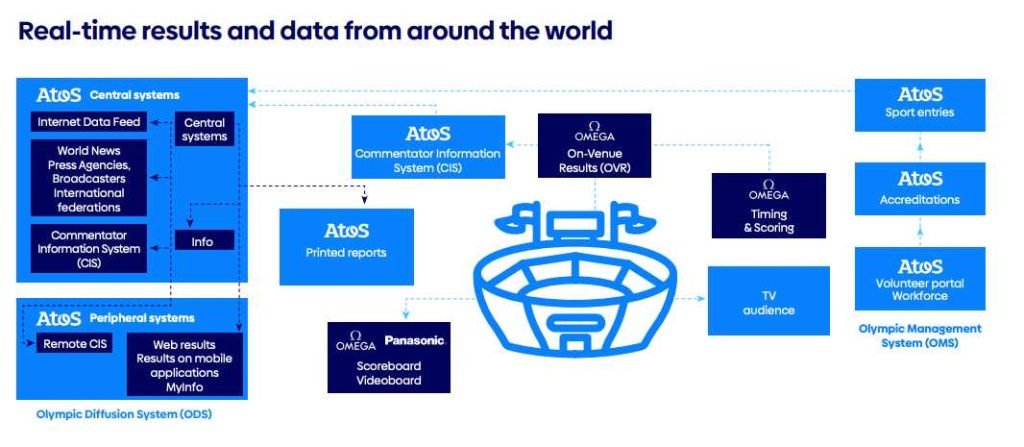Perhaps drawing inspiration from the famous proverb, ‘Like the bamboo bends with the wind, so too must we adapt with technology,' the International Olympic Committee (IOC), set to host the 2024 Olympic and Paralympic Games in Paris, is harnessing digital technology to ensure a seamless and efficient execution of the global event.
The Olympic and Paralympic Games involve multiple venues, thousands of hours of live events, and the management of a vast amount of data. For Paris 2024: there will be 49 competition venues, events will involve an estimated 250,000 hours of testing and the operations will leverage over 150 key applications to manage various aspects of the Games.
Technology at the Forefront of the Olympics
To handle the mammoth task of integrating technology into the operations, the IOC collaborates with technology partners. For instance, Atos plays a key role in providing support for certain information and communication technologies for the Games.
To ensure seamless coordination and real-time response, technology centers have been set up in various cities:
- Paris: The city will have a Technology Operations Center (TOC) which will serve as a coordination hub, ensuring that all tech-related operations across venues run smoothly.
- Madrid: The Integration Testing Lab (ITL) here focuses on testing IOC application integrations, ensuring that all applications are robust and ready for the Games.
- Barcelona: The Central Technology Operations Center (CTOC) provides additional support, managing specific applications crucial for the Paris 2024 Games.
Key Technological Systems
A couple of notable technological systems being used for the Games include: Olympic Diffusion System (ODS) and Olympic Management System (OMS).
Olympic Diffusion System (ODS)
This system centralises data, video feeds, and results, making them accessible to the public. The Olympic Data Feed (ODF) and Web Results System (WRS) are integral parts of this system, ensuring data accuracy and real-time updates.
Basically it is a comprehensive suite of applications engineered to offer an array of data, video, and results, alongside detailed information about the athletes, including their age, nationality, and category. One of its integral components, the Olympic Data Feed (ODF), serves as the nucleus for collecting and centralising results and statistics. It gathers data from On-Venue Results (OVR) systems installed at each competition venue and disseminates this information globally to news agencies, broadcasters, sports federations, and National Olympic Committees.
Moreover, the Web Results System (WRS) plays a crucial role in transforming this data into user-friendly and accessible web pages, available on the official website and mobile application. It offers viewers schedules, results, statistics, medal tallies, and detailed insights about athletes, teams, officials, and even horses, ensuring that every piece of information is easily accessible on a variety of devices, including mobile phones and laptops.
For broadcasters and media professionals, the Commentator Information System (CIS) delivers real-time information and results, facilitating comprehensive coverage whether they are on-site or reporting remotely. MyInfo, another pivotal system, aids journalists by offering content sourced from the IOC's Olympic Information Service. This platform has evolved over the years, and for Paris 2024, it's designed to be more adaptable, allowing users to access information on multiple devices and receive tailored notifications and alerts.
Looking back at Tokyo 2020, there was a significant transformation in the information system. It transitioned from a results-only display to a more dynamic sports news portal, incorporating text, photos, and videos. This evolution underscores the continuous enhancement in the dissemination of information, making it as instantaneous and accessible as possible.
The Print Distribution (PRD) system, meanwhile, ensures that printed reports reach international sports federations, media houses, broadcasters, and VIPs efficiently, based on a pre-configured distribution list, ensuring that in-depth, tangible insights are always at hand for those who prefer or require them.
Olympic Management System (OMS)
It is a suite of applications addressing various requirements ranging from athlete accreditations to event scheduling, assisting in the overall organisation of the Games, while adhering to stringent security and data privacy protocols.
An integral component of the OMS is the volunteer portal, a dynamic platform designed for the systematic recruitment, selection, and management of volunteers. It facilitates various processes, from evaluating the eligibility of candidates for diverse roles to offering real-time updates on application statuses. Selected volunteers are not only invited to interviews but are also granted access to their accreditation details through this interactive portal.
Equally important is the operational team management system, a solution engineered to optimise the allocation of roles, manage costs, and enhance productivity while ensuring compliance with regulatory standards. Its user-friendly, multilingual interface is designed for seamless integration with other information systems, fostering efficiency and collaboration.
In the realm of athlete participation, the athletes' voting application stands out. It's a mechanism to gather athletes' insights by facilitating the electoral process for the IOC Athletes' Commission. This application not only ensures that athletes' voices are integral to the Olympic Movement but also offers an expedited result processing and visual statistical analysis.
Also, the sport entries and qualifications system is pivotal in assessing athletes' and teams' eligibility against established criteria and quotas. The data collated in the accreditation system plays a crucial role in the selection process for participation in the Games.
The competitions schedule system is another cornerstone, offering a streamlined approach to managing and publicising the schedules for the Olympic and Paralympic Games. It ensures synchronisation of competitions and provides a centralised platform for easy access to event schedules.
In the sphere of access control, the accreditation system takes precedence. It administers the issuance of access badges, integrating a robust identity and information management system. This system, fortified with secure connections to law enforcement, homeland security, and immigration agencies, performs comprehensive background checks on each applicant. The badges, beyond granting access to various facilities and event sites, double as visas, enabling entry into the hosting nation for the Olympic and Paralympic Games.

TOC: A Beacon of Coordination
Amidst the tech-driven initiatives, the recent inauguration of the Technology Operations Center (TOC) was noteworthy. Spanning 610 meter square, this center is envisioned as the epicenter for technology, supervising all Olympic and Paralympic venues.
“The opening of the TOC, the IT hub at the heart of Paris 2024, is a key milestone in the final sprint … for athletes, sports federations, the media, and the general public,” said Bruno Marie-Rose, Chief Information and Technology Officer, Paris 2024.
Synchronised Tech Efforts
This tech-embrace isn't confined to Paris. Satellite hubs in Madrid and Barcelona – the Integration Testing Lab (ITL) and Central Technology Operations Center (CTOC) respectively – are crucial cogs in the machine, each with designated roles to guarantee a hiccup-free Games event in 2024.
Christophe Thivet, Chief Integration Officer for Paris 2024, Atos, said, “The success of the Olympic and Paralympic Games largely rests on our capability to flawlessly integrate, manage, and sustain technologies. The TOC's initiation is a testament to the diligent efforts of teams and partners.”
Future-Ready Approaches
The ambitious plans don't end at management. Prompt dissemination of performance data and statistics is pivotal for real-time broadcasting and fan engagement. For instance, the Olympic Diffusion System (ODS) is set to relay data within a tight frame of 0.35 seconds, allowing near-instant access across various devices.
An essential preparatory phase involves ‘Test Events.' These simulated tests, conducted across different venues, act as real-time drills and are gearing up for a comprehensive 250,000 testing hours by July 2024.
As the IOC integrates cutting-edge technology, it will play their part behind the scenes, aiding the true essence of the Games—athletic prowess and global camaraderie.











